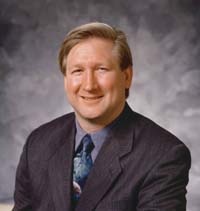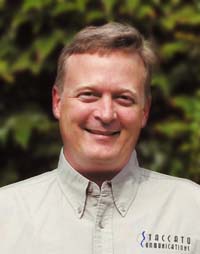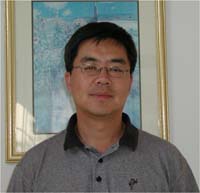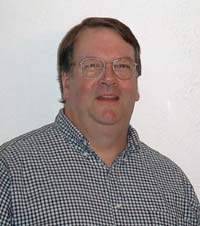Technology Applications
Panel
|
|
|
|
|
PANEL 1: The Quest
for Hardware Standards in Portable Electronics
|
|
Peter
Henry
Moderator
National Semiconductor
|
|
|
|
Peter
Henry is vice president of National Semiconductor Corporation’s
Portable Power Systems product line. He has directed
the group since its establishment in 2000 and is responsible
for product development, market strategy and silicon for
this strategic market segment which focuses on maximizing
battery life in wireless devices.
Peter joined National Semiconductor in 1998 as director
of design for the power management product line.
Prior to National, Peter was the vice president of marketing
for Suni Imaging Systems and held a variety of positions
at Analog Devices, Inc.
Peter earned his Bachelor of Arts Degree in Physics from
the University of California, Berkeley. He completed
the Stanford AEA Executive Institute in 1999.
Industry
standards have been slow to arrive on the portable electronics
scene, resulting in long design cycles and closed system
designs. Panelists from leading organizations will discuss
current efforts to provide open standards on key hardware
interfaces connecting systems such as radios, basebands,
application processors, audio, cameras, displays and power
systems.
|
|
|
|
|
|
PANEL
2: UWB -
Applications and Implications
|
|
Mark
Bowles
Moderator
Founder, Vice President of Business
Development and Marketing
Staccato Communications, Inc.
|
|
|
|
Mr. Bowles has more than 16 years in the semiconductor
industry and most recently was co-founder, president,
COO and director of BOPS, Inc., a broadband DSP cores
and tools company. While at BOPS, he built and led
the business planning, fundraising, operations, and
marketing. Prior to BOPS, he was instrumental in forming
and funding a number of successful start-ups including
Power Computing (sold to Apple in 1996); Panorama
Designs (sold to Motorola in 1996); and BlueSteel
Networks (sold to Broadcom in 2000). He also spent
six years at Motorola Semiconductor where he held
various sales and market development positions. He
left Motorola in 1996 as vice president MSPI, and
PowerPC market development manager to found BOPS.
He is active in UWB standards-setting bodies and is
a voting member of 802.15.3a as well as a founding
member of 802.15.4a. He is also a founding member
of the Multi-band Coalition (www.uwbmultiband.org)
and the Multi-band OFDM Alliance (www.multibandofdm.org).
Mr. Bowles holds an undergraduate engineering degree
from Texas A&M and a master of science degree
in technology management (E-MBA) from Pepperdine University.
Ultra
Wideband (UWB) has received a great deal of attention
in the past year and some are beginning to see the
hype eminiscent of Bluetooth a few years ago. What
is the real state of UWB technology and standards?
Can UWB possibly avoid the 4-6 years of standards
battles, interoperability issues, and slow adoption
cycles that plagued its cousins in unlicensed spectrum
- Bluetooth and 802.11. Panelist will discuss their
views and forecasts for applications based on UWB
spectrum use in the immediate 3 years ahead, the
target customers, markets, and what customer pain
point UWB technology can solve in the next 3 years.
|
|
|
|
|
|
PANEL 3:
Wireless Mesh Networking for the Digital
Home
|
|
Lakshman
Krishnamurthy
Moderator
Network Architecture Lab, Intel Corporation
|
|
|
|
Lakshman
Krishnamurthy is a Senior Staff Engineer, Network
Architecture Lab, Intel Corporation, where he leads
the projects in sensor networks and mesh networking
projects. The sensor network project focuses on
building heterogeneous sensor networks that use
heterogeneity to solve the scaling and resource
constraints in this regime. The team has built numerous
applications including a conference room finder
and an interactive voting network. The project has
also built an Intel® XScale™ based reference
design for a sensor network gateway and Canby, the
compactflash mote NIC. Previously, Lakshman was
an architect of Intel’s digital television
stack, where he contributed to the first nation
wide interactive TV broadcast trial with PBS. He
received B.E. and Ph.D. degrees from the University
of Mysore, India and the University of Kentucky,
respectively.
In
the near future, homes will be equipped with wireless
networks that bridge data and consumer electronics
networks, interconnecting desktop PCs, mobile laptops
and handhelds, High Definition TVs (HDTVs), DVD
players, camcorders, and other multimedia devices.
This environment introduces new wireless network
requirements, including high and dependable bandwidth,
low latency, and coverage throughout the home.
In a wireless home network today a wireless-enabled
device, such as a laptop, directly connects to the
network through an access point. This is known
as a single hop network. In the future, homes
will use multi-hop networks, also known as mesh
networks, to connect all the devices in the home
to each other or to a broadband connection.
In a multi-hop network, a device can connect to
its destination through wireless routers, essentially
taking many hops to complete a data connection from
the client device to a broadband connection.
Multi-hop wireless technology offers unique benefits
for creating a high-speed, robust home wireless
network. The benefits over traditional infrastructure
wireless networks include extending coverage without
requiring deployment of multiple wired base stations,
increasing utilization of spatial capacity to realize
higher throughput, and offering alternate communication
paths to provide failure recovery and better throughput.
Intel R&D is researching these self-organizing
multi-hop wireless networks for home environments.
This panel will discuss the evolution of wireless
home networking, the role of mesh networking, and
the usage models that will require this technology.
|
|
|
|
|
|
PANEL
4: Power
Line Communications: from skepticism to
reality
|
|
Stefano
Galli
Moderator
Telcordia Technologies
|
|
|
|
Stefano
Galli received his M.S. and Ph.D. in Electrical
Engineering from the University of Rome "La
Sapienza" (Rome, Italy) in 1994 and 1998, respectively.
In October 1998, Dr. Galli joined Bellcore (now
Telcordia Technologies, an SAIC company) in Morristown,
NJ, in the Broadband Networking Research Department
where he is now a Senior Scientist. Dr. Galli's
main research efforts are devoted to various aspects
of xDSL systems, wireless/wired home networks, personal
wireless communications, power line communications,
and optical CDMA. His research interests also include
detection and estimation, communications theory,
and signal processing. Dr. Galli is an IEEE member,
a reviewer for several IEEE journals, has published
over 50 papers in peer reviewed international journals
and conferences, and holds a US patent on Loop Qualification
for DSL services. Dr. Galli also served as a Guest
Editor for the IEEE Communications Magazine feature
topic "Broadband is Power: Internet Access
via the Power Line Network" (May 2003), and
is currently serving as Technical Program Committee
member for the 2004 Spring IEEE Vehicular Technology
Conference (VTC'04), the 2004 IEEE International
Symposium on Power Line Communications (ISPLC'04),
and the 2004 IEEE International Conference on Communications
(ICC'04).
Power
line communications has been lately gaining more
and more attention around the world. The attractive
feature of using power cables as a communications
medium is that there is a vast infrastructure in
place that has a much higher penetration than any
other wired solution. Despite the enormous potential,
there is still some skepticism about the technology
and its commercial viability due to several technical
problems and regulatory issues that still remain
to be solved. In this panel, we will discuss advantages
and disadvantages of this emerging technology, focusing
both on the technical challenges and on the commercial
viability of power line communications as a means
for broadband access and home-based LAN.
|
|
|
|
|
|
PANEL
5: The Networked
Home: Where is the packaged media?
|
|
Richard
E. Doherty
Moderator
|
|
|
Richard
Doherty graduated from Caltech with a degree
in Electrical Engineering, and shortly thereafter
co-founded the startup Silerity, with the mission
to deliver datapath synthesis tools to the design
automation market. After successfully delivering
the PathBlazer product, Silerity was purchased by
Synopsys, and Richard left to pursue his creative
side for a time. Richard earned an MFA in Film Production
from the USC film school, and went on to win a dozen
festival directing awards for his thesis film, My
Chorus. Richard joined the startup CineForm, where
he served as Principal Architect for the real-time
HD video editing platform, Aspect HD. Richard now
serves as Director of Professional A/V at Panasonic
Hollywood Labs, where he is focusing on new products
for the professional market.
The
delivery of high-definition video content to consumers
has been gearing up for a number of years, and some
very high-profile HiDef optical disc formats are
nearing their market debut. Ten years ago, the idea
of distributing a movie on a single self-contained
disc seemed like a pretty good idea, and a decade
of enormous profit has flowed from the DVD format.
But in the living room of the future, where content
may reside in any number of forms on a variety of
media, and an array of delivery methods may exist
and interoperate, is there still a place for the
shrink-wrapped disc? Given the convenience, capacity
and superior quality of optical discs combined with
the vast preexisting sales infrastructure of DVD
that includes pressing, designing, packaging, and
shipping, the optical disc will likely be an efficient
format for delivery of content to the consumer.
But when it gets to the consumer, what happens?
How does he use this prerecorded content in his
newly networked entertainment environment? What
new benefits will the networked home offer for both
content creators and content consumers? How much
content is included on the disc, and how much is
withheld for later download? How much of the content
will be modified through network connectivity after
the discs are already in the hands of the consumer?
Finally, is there any way to protect this content
that satisfies both studios and consumers? This
panel brings together the representatives of the
latest optical disc technologies along with the
Hollywood visionaries and studio technologists to
discuss the future of content delivery.
|
|
|
|
|
|
PANEL
6: Linux
for Networked CE Devices
|
|
IP
Park
Moderator
|
|
|
|
I.P.
Park is a Lead Scientist at Panasonic Information
and Networking Technologies Laboratory in Princeton,
New Jersey, U.S.A., where he directs research in
operating system security and secure download technologies.
Dr. Park is involved in various standards activities,
including CE Linux Forum, Embedded Linux Consortium,
Open Mobile Alliance, Software Defined Radio Forum,
and Java Community Process. Prior to joining Panasonic,
Dr. Park was an Associate Professor in the Department
of Computer Science at New York Institute of Technology.
He holds Ph.D. and M.S. degrees in Computer Science
from Columbia University, and a B.S. degree in Computer
Science from Seoul National University
Linux
is an open source operating system, which is rapidly
gaining popularity in the consumer electronics market.
Linux based networked CE products have already been
introduced by several CE manufacturers, including
settop boxes, PDAs, and smart phones. There are
several advantages of using Linux in the CE space.
It is an open source operating system developed
under General Public License (GPL), and the source
code is freely available to everyone. Linux has
been around for over a decade and is being developed
and supported by numerous people. It is considered
one of the most stable general-purpose operating
systems that is supported by a vast number of software
programmers. It supports most network protocols,
has been ported to a wide variety of processors,
and the entire source code is available for everyone
to use and to modify. However, there are downsides
of using Linux in the consumer electronics space
as well. Linux has its origin in the desktop and
server spaces, and therefore it is not optimized
for use in CE products. In order for Linux to be
useful as an operating system for CE products, functional
enhancements must be made in areas such as memory
footprint, response time, power management, security,
and reliability. Furthermore, FUD (Fear, Uncertainty,
Doubt) is preventing a more aggressive penetration
of Linux in the CE market. One of the most important
issues that have not yet been fully tested is the
use of GPL, which is a copyright license and is
silent on patent licensing. This panel discussion
will bring together representatives of the entire
CE Linux value chain, including CE manufacturers,
embedded Linux vendors, and the Linux community
to discuss the future of Linux in the CE market.
|
|
|
|
|
|
PANEL
7: OSGi Technology
- Enabling the Networked Delivery of Managed
Services
|
|
Stan
Moyer
Moderator
Telcordia Technologies
|
|
|
Stan
Moyer is Executive Director and Strategic
Research Program Manager in the Applied Research
organization of Telcordia Technologies. His main
research focus is currently Home Networking and
Networked (a.k.a. Internet or IP) Appliances - specifically
understanding the issues and network requirements
associated with this new breed of end device. He
has also worked in the capacity of project manager
for several Internet Service Quality related projects
in Applied Research and for the Leveraging Web,
Distributed Objects and Client/Server for Telcordia
OSSs project for the Telcordia Software Systems
organization. He is also a member of the OSGi Board
of Directors, editor of the In-Home Networking series
for IEEE Communications Magazine, and a newly elected
representative to the IEEE Communications Society
Board of Governors. Stan received his Bachelor of
Science in Engineering Physics from the University
of Maine and his Masters of Engineering in Electrical
Engineering from Steven's Institute of Technology
in Hoboken, NJ. Stan is also currently pursing an
MBA in Technology Management.
This
panel will address Residential Gateway technologies.
Particularly we will discuss issues related to the
OSGi Alliance
specifications and technology:
• The evolution and key capabilities of the
OSGi Service Platform
• How OSGi relates to other technologies such
as .Net and Java
• The current OSGi value proposition, attributes,
and developer benefits
• What's new regarding the positioning and
rebranding of the OSGi technology
The OSGi Alliance is an open forum whose mission
is to specify, create, advance, and promote an open
service platform for the delivery and management
of multiple applications and services to all types
of networked devices in home, vehicle, mobile and
other environments. The OSGi Alliance serves as
the focal point for a collaborative ecosystem of
service provider, technology, industrial, consumer
and automotive electronics communities.
|
|
|
|
|
|
Distinguished
Experts Panel: Bringing Home the Bits:
Alternatives for Residential Broadband
Access
|
|
Edward
S. Szurkowski
Moderator
Bell Laboratories, Lucent Technologies
|
|
|
|
The
ongoing development and expansion of consumer networking
is critically dependent on the availability of broadband
connections from residences to public telecom networks.
Over the past few years, significant residential
broadband access deployment has begun in the USA
and globally, using a variety of technologies and
business models.
This panel will explore these broadband access alternatives,
their technical strengths & weaknesses, deployment
and business objectives to provide insights for
guiding the direction of consumer networking.
The panelists will represent a range of access service
providers, technologies and geographies.
Each panelist will describe their current broadband
access program, the rationale for making their technology
choice, the services they provide, their challenges,
and their view on deployment timing and coverage.
They will be asked to describe new technologies
or devices they would like to see from the consumer
electronics industry, and to discuss how the telecom
and consumer networking research communities might
collaborate to advance new residential communication
services and capabilities.
The panel invitees will be selected for their ability
to discuss both the technology and business issues
of broadband access, along with a vision for new
services and the substantial opportunities in consumer
electronics and networking.
|
|
|
|







